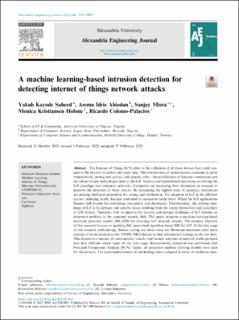| dc.contributor.author | Saheed, Yakub Kayode | |
| dc.contributor.author | Abiodun, Aremu Idris | |
| dc.contributor.author | Misra, Sanjay | |
| dc.contributor.author | Holone, Monica Kristiansen | |
| dc.contributor.author | Colomo-Palacios, Ricardo | |
| dc.date.accessioned | 2022-12-14T17:56:54Z | |
| dc.date.available | 2022-12-14T17:56:54Z | |
| dc.date.created | 2022-03-29T08:34:38Z | |
| dc.date.issued | 2022 | |
| dc.identifier.citation | Alexandria Engineering Journal. 2022, 61 (12), 9395-9409. | en_US |
| dc.identifier.issn | 1110-0168 | |
| dc.identifier.uri | https://hdl.handle.net/11250/3037789 | |
| dc.description.abstract | The Internet of Things (IoT) refers to the collection of all those devices that could connect to the Internet to collect and share data. The introduction of varied devices continues to grow tremendously, posing new privacy and security risks—the proliferation of Internet connections and the advent of new technologies such as the IoT. Various and sophisticated intrusions are driving the IoT paradigm into computer networks. Companies are increasing their investment in research to improve the detection of these attacks. By comparing the highest rates of accuracy, institutions are picking intelligent procedures for testing and verification. The adoption of IoT in the different sectors, including health, has also continued to increase in recent times. Where the IoT applications became well known for technology researchers and developers. Unfortunately, the striking challenge of IoT is the privacy and security issues resulting from the energy limitations and scalability of IoT devices. Therefore, how to improve the security and privacy challenges of IoT remains an important problem in the computer security field. This paper proposes a machine learning-based intrusion detection system (ML-IDS) for detecting IoT network attacks. The primary objective of this research focuses on applying ML-supervised algorithm-based IDS for IoT. In the first stage of this research methodology, feature scaling was done using the Minimum-maximum (min–max) concept of normalization on the UNSW-NB15 dataset to limit information leakage on the test data. This dataset is a mixture of contemporary attacks and normal activities of network traffic grouped into nine different attack types. In the next stage, dimensionality reduction was performed with Principal Component Analysis (PCA). Lastly, six proposed machine learning models were used for the analysis. The experimental results of our findings were evaluated in terms of validation dataset, accuracy, the area under the curve, recall, F1, precision, kappa, and Mathew correlation coefficient (MCC). The findings were also benchmarked with the existing works, and our results were competitive with an accuracy of 99.9% and MCC of 99.97%. | en_US |
| dc.language.iso | eng | en_US |
| dc.publisher | Elsevier | en_US |
| dc.rights | Attribution-NonCommercial-NoDerivatives 4.0 Internasjonal | * |
| dc.rights.uri | http://creativecommons.org/licenses/by-nc-nd/4.0/deed.no | * |
| dc.subject | intrusion detection system | en_US |
| dc.subject | machine learning | en_US |
| dc.subject | Internet of Things | en_US |
| dc.subject | min-max normalization | en_US |
| dc.subject | UNSWNB-15 | en_US |
| dc.subject | principal component analysis | en_US |
| dc.subject | cat boost | en_US |
| dc.subject | XgBoost | en_US |
| dc.title | A machine learning-based intrusion detection for detecting internet of things network attacks | en_US |
| dc.type | Peer reviewed | en_US |
| dc.type | Journal article | en_US |
| dc.description.version | publishedVersion | en_US |
| dc.rights.holder | © 2022 THE AUTHORS. | en_US |
| dc.subject.nsi | VDP::Teknologi: 500 | en_US |
| dc.source.pagenumber | 9395-9409 | en_US |
| dc.source.volume | 61 | en_US |
| dc.source.journal | Alexandria Engineering Journal | en_US |
| dc.source.issue | 12 | en_US |
| dc.identifier.doi | 10.1016/j.aej.2022.02.063 | |
| dc.identifier.cristin | 2013188 | |
| cristin.ispublished | true | |
| cristin.fulltext | original | |
| cristin.qualitycode | 1 | |

